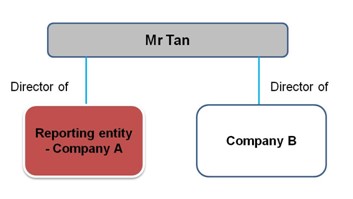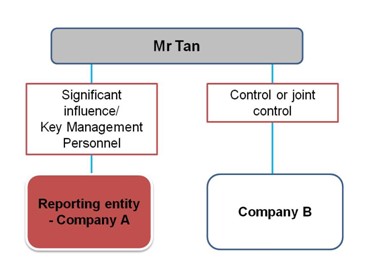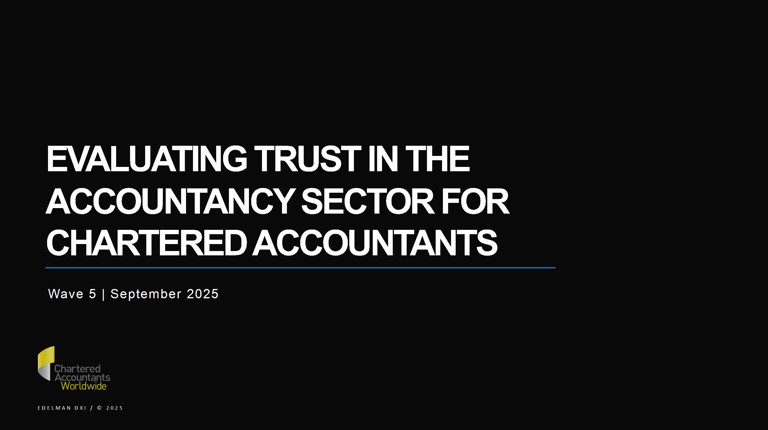Others
The requirements in FRS 8 shall be applied in selecting and applying accounting policies, and accounting for changes in accounting policies, changes in accounting estimates and corrections of prior period errors. Accounting policies are defined in FRS 8 paragraph 5 as the specific principles, bases, conventions, rules and practices applied by an entity in preparing and presenting financial statements.
Consider the following scenario:
Entity A has one subsidiary and is wholly owned by another entity B. In prior years, entity A has been preparing consolidated financial statements, notwithstanding that entity A meets the criteria set out in paragraph 4(a) of FRS 110 Consolidated Financial Statements for the exemption on the preparation of consolidated financial statements. Entity A chooses to apply the exemption and prepare separate financial statements for the current financial year. Should entity A consider this as a change in accounting policy under FRS 8?
Separate financial statements and consolidated financial statements are two distinct sets of financial statements. Therefore, this is not a change in accounting policy under FRS 8. When an entity chooses to apply the exemption from preparing consolidated financial statements in the current financial year (in place of consolidated financial statements), Entity A effectively ceases to prepare consolidated financial statements and commences the preparation of separate financial statements.
Accordingly, FRS 27 Separate Financial Statements applies when an entity produce separate financial statements. FRS 27 paragraph 9 requires the preparation of separate financial statements in accordance with all applicable FRSs, except for accounting for investments in subsidiaries, joint ventures and associates in paragraph 10. This would mean that the opening balances in the separate financial statements are to be presented as though the entity has been preparing separate financial statements all along. In addition, paragraph 16 requires a parent entity that elects not to prepare consolidated financial statements to include the disclosures as listed in (a) – (c) in their separate financial statements.
Publication Date: 30 December 2016
Written by: Lim Ju May & Jezz Chew, Corporate Reporting & Ethics (CoRE)
To illustrate: Mr Tan is a director in Company A (reporting entity) and Company B.

This scenario is addressed in paragraph 9(b)(vi) of FRS 24. It states that an entity (Company B) is related to a reporting entity (Company A) if the entity (Company B) is controlled or jointly controlled by a person identified in paragraph 9(a) of FRS 24.
Paragraph 9(a) of FRS 24 states that a person is related to a reporting entity (Company A) if that person:
(i) has control or joint control of the reporting entity (Company A); or
(ii) has significant influence over the reporting entity (Company A); or
(iii) is a member of the key management personnel of the reporting entity (Company A) or of a parent of the reporting entity.
Is Mr Tan a related party to Company A and Company B respectively?
As a director of the reporting entity (Company A), Mr Tan would fall under the definition of key management personnel under paragraph 9 of FRS 24. Accordingly, Mr Tan is a related party to Company A. Similarly, Mr Tan is also a related party to Company B because he is also a director of Company B.
Is Company B a related party of Company A?
However, whether Company B is a related party of Company A will depend on whether Mr Tan controls or jointly controls Company B. The fact that Mr Tan is a director in both Company A and Company B does not automatically result in Company A and Company B becoming related parties.

Publication Date: 29 December 2017
Written by: Felicia Tay & Lim Ju May, Corporate Reporting and Ethics (CoRE)
By way of illustration, Company A, which has a 31 December financial year end, owns two properties which were accounted for as property, plant and equipment according to FRS 16 Property, Plant and Equipment. Mid way during the financial year 2017, Company A restructured one of its business units under a subsidiary as a separate legal entity (Company B). Company B continued to occupy the property of Company A and commenced paying rental to Company A. The arrangement is for Company B to occupy the property for a one year transition period and return it vacant to Company A at the end of the transition period. Company A would then continue to utilise the property for its own business operations and account for the property as property, plant and equipment.
Should Company A reclassify the property (leased out to Company B) from property, plant and equipment to investment property at 31 December 2017?
Consolidated financial statements of Company A
In the consolidated financial statements, Company A, continues to classify the property as property, plant and equipment as the consolidated group continues to hold the property for its own use,
Separate financial statements of Company A
Paragraph 5 of FRS 40 Investment Property defines an investment property as property (land or a building – or part of a building – or both) held (by the owner or by the lessee as a right-of-use asset) to earn rentals or for capital appreciation or both, rather than for:
(a) Use in the production or supply of goods or services or for administrative purposes; or
(b) Sale in the ordinary course of business.
Based on the above definition of investment property, the property is an investment property if it is currently held to earn rentals. Technically, during the transition period, the property is an investment property from Company A’s perspective as a legal entity separate from Company B and it should be classified as such. Whether or not there is room for a slight departure from a strict classification of this property as an investment property is dependent on the materiality of this treatment and the length of time that the subsidiary, Company B temporarily uses this property before returning it to Company A for its own use.
Publication Date: 29 December 2017
Written by: Alice Tan & Lim Ju May, Corporate Reporting and Ethics (CoRE)
(a) Buyer’s stamp duty
The Inland Revenue Authority of Singapore (“IRAS”) has defined1 “buyer’s stamp duty” as “tax paid on documents signed when you buy or acquire property located in Singapore”.
Paragraph 16(a) of FRS 16 states that the cost of an item of property, plant and equipment comprises its purchase price, including import duties and non-refundable purchase taxes, after deducting trade discounts and rebates.
Although FRS 16 does not specify what “non-refundable purchase taxes” refers to, it is reasonable to consider buyer’s stamp duty as part of such taxes. Hence, stamp duty would be capitalised as part of the cost of the property.
(b) Commission paid to the agent (refers to the fee that is paid to the agent for the successful transaction, and the fee is usually a small percentage of the purchase price)
This issue concerns the types of costs that can be capitalised as cost of an item of property, plant and equipment at initial recognition.
Under paragraph 16 of FRS 16, the cost of an item of property, plant and equipment comprises:
(a) Its purchase price, including import duties and non-refundable purchase taxes, after deducting trade discounts and rebates.
(b) Any costs directly attributable to bringing the asset to the location and condition necessary for it to be capable of operating in the manner intended by management.
(c) The initial estimate of the costs of dismantling and removing the item and restoring the site on which it is located, the obligation for which an entity incurs either when the item is acquired or as a consequence of having used the item during a particular period for purposes other than to produce inventories during that period.
“Professional fees” is provided as an example of “directly attributable costs” under paragraph 17 of FRS 16.
Based on the above, it is not clear whether the commission paid to agent could be capitalised as part of the cost of the property.
One view is that the cost of property, plant and equipment does include expenditure that is incurred only if an asset is acquired. For example, a fee may be payable to a broker or agent only if a suitable property is identified and bought. We believe that such a fee is directly attributable to the acquisition of the property acquired and therefore should be included in the cost of the property.
Another similar view states that external professional fees incurred in finding a suitable asset, which is then acquired or constructed, can be capitalised. External professional fees should only be capitalised as part of the cost of an asset where they relate directly to the acquisition or construction of the asset.
ISCA CoRE’s view
The commission paid to the agent is a necessary cost incurred to acquire and own the property and incurred only if the asset is acquired. In our view, it is appropriate to capitalise the commission paid to the agent as part of the cost of the property.
Publication Date: 29 December 2017
Written by: Felicia Tay & Lim Ju May, Corporate Reporting and Ethics (CoRE)
FRS 110 Consolidated Financial Statements paragraph 4(a) provides an exemption for a parent not to present consolidated financial statements if it meets all the conditions (i) to (iv) as listed in the same paragraph. One of the conditions is that its ultimate or any intermediate parent produces financial statements that are available for public use, in which subsidiaries are consolidated or are measured at fair value through profit or loss. However, FRS 110 does not provide a definition of public use.
International Accounting Standards Board (IASB) shared in their Basis for Conclusion that the exemption for the preparation of consolidated financial statements is given for entities within a group so that it is not unduly burdened with the need to produce multiple sets of consolidated financial statements. In addition, users may find information they require about a subsidiary from either its separate financial statements or from the consolidated financial statements in some circumstances.
In consideration of IASB’s intention for the exemption, it would appear reasonable to infer that the criterion on the availability of its ultimate or any intermediate parent for public use is fulfilled when the consolidated financial statements of its ultimate or any intermediate parent are publicly available through a regulatory filing requirement, or when these consolidated financial statements are available on request.
FRS 27 Separate Financial Statements paragraph 16 states that when a parent, in accordance with paragraph 4(a) of FRS 110, elects not to prepare consolidated financial statements and instead prepares separate financial statements, it shall disclose in those separate financial statements:
- the fact that the financial statements are separate financial statements;
- that the exemption from consolidation has been used;
- the name and principal place of business (and country of incorporation, if different) of the entity whose consolidated financial statements have been produced for public use; and
- the address where those consolidated financial statements are obtainable.
An entity that uses the exemption from preparing consolidated financial statements must disclose the source from which the financial statements of the relevant parent of the reporting entity can be obtained.
Publication Date: 29 December 2017
Written by: Jezz Chew & Lim Ju May, Corporate Reporting and Ethics (CoRE)
An entity may present its financial statements in any currency. If the presentation currency differs from the entity’s functional currency, the entity translates its results and financial position into the presentation currency in accordance with the requirements of FRS 21.
For the translation into a presentation currency, FRS 21 specifies that assets and liabilities are translated at the exchange rate at the end of the period and income and expenses are translated at the exchange rates at the dates of the transactions. While not explicitly stated in FRS 21, it is implied that the equity being the difference between assets and liabilities must be translated at the exchange rate at the end of the period.
However, FRS 21 does not prescribe which exchange rate is used to translate the components within equity. One approach is to preserve the closing balances (in terms of presentation currency) of all components within equity at the end of the previous financial period and bring such balances forward as the opening balances at the beginning of the current financial period (historical rate method) and disclose the effect of re-translation at the end of the current financial period as a reserve movement. Another approach is to re-translate all components within equity at the end of the current financial period at the exchange rate at the end of the period (closing rate method) and embed the effect of re-translation within each of the components.
We are of the view that in the absence of specific guidance in FRS 21, a reporting entity can choose either approach as its accounting policy.
Publication Date: 29 December 2017
Written by: Felicia Tay & Lim Ju May, Corporate Reporting and Ethics (CoRE)
Note:
|
In practice, it is common for a parent company (or the lender entity) to provide advances to its subsidiary (or the borrower entity). These advances typically do not have stated repayment dates and are callable by the lender entity on demand.
The following questions arise:
(i) Should such receivables be classified as current or non-current assets in the lender entity’s financial statements?
(ii) If the receivables are classified as current assets, should the payables be correspondingly classified as current liabilities in the borrower entity’s financial statements and vice versa?
Lender entity’s financial statements
Paragraph 66 of FRS 1 Presentation of Financial Statements states that:
“An entity shall classify an asset as current when:
(a) it expects to realise the asset, or intends to sell or consume it, in its normal operating cycle;
(b) it holds the asset primarily for the purpose of trading;
(c) it expects to realise the asset within twelve months after the reporting period; or
(d) the asset is cash or a cash equivalent unless the asset is restricted from being exchanged or used to settle a liability for at least twelve months after the reporting period.
An entity shall classify all other assets as non-current.”
In the situation where there is no stated repayment date for the receivable amount and the amount is callable by the lender entity on demand, the lender entity is required to assess whether the receivable fulfils the criteria in paragraph 66 of FRS 1 to determine the appropriate classification of the receivable. When doing so, attention needs to be given to the underlying substance and economic reality and not merely to the legal form. In other words, the lender entity is required to consider its expectations in relation to the receivable amount. The classification of a financial asset is based on whether the entity expects to convert it into cash or use it in the business within one year/the normal operating cycle. Typically, if the advances are intended for ongoing financing of the subsidiary by the lender, they would be classified as non-current receivables.
Borrower entity’s financial statements
Paragraph 69 of FRS 1 states that:
“An entity shall classify a liability as current when:
(a) it expects to settle the liability in its normal operating cycle;
(b) it holds the liability primarily for the purpose of trading;
(c) the liability is due to be settled within twelve months after the reporting period; or
(d) it does not have an unconditional right to defer settlement of the liability for at least twelve months after the reporting period (see paragraph 73). Terms of a liability that could, at the option of the counterparty, result in its settlement by the issue of equity instruments do not affect its classification.
An entity shall classify all other liabilities as non-current.”
In the situation where there is no stated repayment date for the amount payable and the advance is callable by the lender entity on demand, paragraph 69(d) of FRS 1 would require the borrower entity to classify the amount as a current liability as it “does not have an unconditional right to defer settlement of the liability for at least twelve months after the reporting period”. In other words, the borrower entity is required to consider its contractual obligation in relation to the payable amount. The default classification of a financial liability is current unless the entity has an unconditional right to defer settlement of the liability for at least 12 months after the financial reporting date.
It should also be noted that the current/non-current classification of the advance will be assessed independently for the receivable and the liability; there is no symmetry as the criteria are different for the asset and liability classification.
Because the non-current classification for a financial liability is based on hard evidence of an unconditional right, often an amount due to a related entity fails to meet the requirement for such classification. On the other hand, as the current classification of a financial asset is based on expectations, often it is quite apparent that the intragroup balance is not expected to be settled within 12 months. Hence, we have a current liability classification by one entity and a non-current asset classification by another entity.
Publication Date: 23 November 2018
Written by: Felicia Tay & Lim Ju May, Corporate Reporting and Ethics (CoRE)
Note:
|
Background
The IFRS Interpretations Committee (“Interpretations Committee”) works with the International Accounting Standards Board (Board) in supporting the application of IFRS Standards.
The Interpretations Committee received a submission about the capitalisation of borrowing costs in relation to the construction of a residential multi-unit real estate development (building). Applying IFRS 15 Revenue from Contracts with Customers, the real estate developer (“entity”) recognises revenue over time for the sale of individual units in the development. The submission asked whether the real estate developer capitalises borrowing costs as part of the cost of the units.
At the Interpretations Committee’s meeting on 27 November 2018[1] , the Interpretations Committee tentatively decided not to add this matter to its standard-setting agenda and a Tentative Agenda Decision[2] containing explanatory material for the decision and how the applicable principles and requirements in IAS 23 Borrowing Costs apply to the fact pattern in the submission was issued. The Interpretations Committee tentatively concluded that, the entity should not capitalise borrowing costs. This conclusion may be different from the accounting policies applied currently by residential real estate developers in Singapore reporting under SFRS(I) or FRS.
Please refer to Appendix A (see below) for the Tentative Agenda Decision which is open for comments until 6 February 2019.
What is a tentative agenda decision?
The Interpretations Committee discusses application questions submitted by stakeholders to assess whether any change is needed to IFRS Standards. When the Interpretations Committee concludes that the principles and requirements in the Standards provide an adequate basis for an entity to determine the appropriate accounting, the Interpretations Committee publishes an agenda decision. The agenda decision includes explanatory materials outlining the Interpretations Committee’s view on how to apply the applicable principles and requirements in the IFRS Standards to the question submitted. All agenda decisions are subject to due process. The Interpretations Committee publishes a tentative agenda decision which is open for comments for 60 days after their meeting. The Interpretations Committee considers comments received before finalising the agenda decision.
What should entities do next?
As SFRS(I) 1-23 / FRS 23 and SFRS(I) 15 / FRS 115 are aligned to IAS 23 and IFRS 15 respectively, the above Tentative Agenda Decision would also be relevant to Singapore entities reporting under SFRS(I) or FRS.
The tentative agenda decision includes explanatory material to facilitate greater consistency in the application of the IFRS Standards. Entities should consider the tentative agenda decision (including the explanatory material) and evaluate whether a change in the entity’s accounting policy is necessary and whether additional disclosures on the potential impact should be included in the financial statements. Where necessary, entities should also engage professional advisors.
As tentative agenda decisions (including explanatory material) are subject to finalisation by the Interpretations Committee after consideration of the comments received, the above evaluation should be updated when the agenda decision is finalised after February 2019.
Notwithstanding the above, it should be noted that if the tentative agenda decision is finalised in its current form (i.e. with no amendments to the content of the agenda decision), it will be an adjusting event for entities whose financial statements have yet to be authorised for issue on the date that the agenda decision is finalised.
Appendix A
Tentative agenda decision – Over time transfer of constructed good The Committee received a request about the capitalisation of borrowing costs in relation to the construction of a residential multi-unit real estate development (building). In the fact pattern described in the request:
The request asks whether the entity has a qualifying asset as defined in IAS 23 and, therefore, capitalises any directly attributable borrowing costs. Applying paragraph 8 of IAS 23, an entity capitalises borrowing costs that are directly attributable to the acquisition, construction or production of a qualifying asset as part of the cost of that asset. Paragraph 5 of IAS 23 defines a qualifying asset as ‘an asset that necessarily takes a substantial period of time to get ready for its intended use or sale’. Accordingly, the entity assesses whether, in the fact pattern described in the request, it recognises an asset that necessarily takes a substantial period of time to get ready for its intended use or sale. Depending on the particular facts and circumstances, the entity might recognise a receivable, a contract asset and/or inventory. The Committee concluded that, in the fact pattern described in the request, the entity does not capitalise borrowing costs. The Committee observed that:
The Committee concluded that the principles and requirements in IAS 23 provide an adequate basis for an entity to determine whether to capitalise borrowing costs in the fact pattern described in the request. Consequently, the Committee [decided] not to add this matter to its standard-setting agenda. |
[1] IFRIC Update November 2018: https://www.ifrs.org/news-and-events/updates/ifric-updates/november-2018/#4
[2] Tentative Agenda Decision: https://www.ifrs.org/projects/work-plan/over-time-transfer-of-constructed-good-ias-23/comment-letters-projects/tad-over-time-transfer-of-constructed-good/
Publication Date: 31 December 2018
Revised Date: 24 April 2019
Written by: Felicia Tay & Lim Ju May, Technical: Financial & Corporate Reporting
Background
ISCA has previously issued a Technical Bite 8 on Capitalisation of Borrowing Costs on 31 December 2018. This Technical Bite was issued to raise awareness of a Tentative Agenda Decision issued by the IFRS Interpretations Committee (“Interpretations Committee”) in November 2018. We reminded entities to consider the Tentative Agenda Decision and evaluate whether a change in the entity’s accounting policy is necessary and whether additional disclosures on the potential impact should be included in the financial statements.
We have also submitted a comment letter to the Interpretations Committee to raise our concerns regarding the Tentative Agenda Decision.
At the time of issuance of the Technical Bite, we highlighted that tentative agenda decisions are subject to finalisation by the Interpretations Committee after consideration of the comments received.
IFRS Interpretations Committee meeting on 5 March 2019 in London
During the March meeting of the Interpretations Committee, this Tentative Agenda Decision was discussed and finalised. Please see Appendix A for the finalised Agenda Decision, where changes from the Tentative Agenda Decision are tracked.
The Interpretations Committee’s finalised Agenda Decision is consistent with the Tentative Agenda Decision of not allowing capitalisation of borrowing costs under the specified fact pattern – property developers that recognise revenue over time.
During their meeting, the Interpretations Committee also recommended the inclusion of the following to accompany agenda decisions in view that agenda decisions do not have an effective date:
The process for publishing an agenda decision might often result in explanatory material that provides new information that was not otherwise available and could not otherwise reasonably have been expected to be obtained. Because of this, an entity might determine that it needs to change an accounting policy as a result of an agenda decision. The Board expects that an entity would be entitled to sufficient time to make that determination and implement any change (for example, an entity may need to obtain new information or adapt its systems to implement a change).
What is meant by ‘sufficient time’?1
ISCA, through its Financial Reporting Committee (FRC) Core Sub-Committee, has deliberated on what is 'sufficient time'.
Barring any exceptional circumstances, it would be reasonable to expect entities to implement the change in accounting policy resulting from the agenda decision, as soon as possible and no later than 31 December 2019.
Appendix A
The process for publishing an agenda decision might often result in explanatory material that provides new information that was not otherwise available and could not otherwise reasonably have been expected to be obtained. Because of this, an entity might determine that it needs to change an accounting policy as a result of an agenda decision. The Board expects that an entity would be entitled to sufficient time to make that determination and implement any change (for example, an entity may need to obtain new information or adapt its systems to implement a change).
Agenda decision – Over time transfer of constructed good (IAS 23 Borrowing Costs) The Committee received a request about the capitalisation of borrowing costs in relation to the construction of a residential multi-unit real estate development (building). In the fact pattern described in the request: a. a real estate developer (entity) constructs the building and sells the individual units in the building to customers. b. the entity borrows funds specifically for the purpose of constructing the building and incurs borrowing costs in connection with that borrowing. c. before construction begins, the entity signs contracts with customers for the sale of some of the units in the building (sold units). d. the entity intends to enter into contracts with customers for the remaining part-constructed units (unsold units) as soon as it finds suitable customers. e. the terms of, and relevant facts and circumstances relating to, the entity’s contracts with customers (for both the sold and unsold units) are such that, applying paragraph 35(c) of IFRS 15 Revenue from Contracts with Customers, the entity transfers control of each unit over time and, therefore, recognises revenue over time. The consideration promised by the customer in the contract is in the form of cash or another financial asset. The request asks whether the entity has a qualifying asset as defined in IAS 23 and, therefore, capitalises any directly attributable borrowing costs. Applying paragraph 8 of IAS 23, an entity capitalises borrowing costs that are directly attributable to the acquisition, construction or production of a qualifying asset as part of the cost of that asset. Paragraph 5 of IAS 23 defines a qualifying asset as ‘an asset that necessarily takes a substantial period of time to get ready for its intended use or sale’. Accordingly, the entity assesses whether, in the fact pattern described in the request, it recognises an asset that necessarily takes a substantial period of time to get ready for its intended use or sale. Depending on the particular facts and circumstances, the entity might recognise a receivable, a contract asset and/or inventory. The Committee concluded that, in the fact pattern described in the request, the entity does not capitalise borrowing costs. The Committee observed that: a. any a receivable that the entity recognises is not a qualifying asset. Paragraph 7 of IAS 23 specifies that financial assets are not qualifying assets. b. any a contract asset that the entity recognises is not a qualifying asset. The contract asset (as defined in Appendix A to IFRS 15) would represent the entity’s right to consideration that is conditioned on something other than the passage of time in exchange for transferring control of a unit. The intended use of the contract asset—to collect cash or another financial asset—is not a use for which it necessarily takes a substantial period of time to get ready. c. any inventory (work-in-progress) for unsold units under construction that the entity recognises is not a qualifying asset. In the fact pattern described in the request, this asset is ready for its intended sale in its current condition—ie the entity intends to sell the part-constructed units as soon as it finds suitable customers and, on signing a contract with a customer, will transfer control of any work-in-progress relating to that unit to the customer. The Committee concluded that the principles and requirements in IAS 23 provide an adequate basis for an entity to determine whether to capitalise borrowing costs in the fact pattern described in the request. Consequently, the Committee decided not to add this matter to its standard-setting agenda. |
[1] IASB’s Vice-Chair, Sue Lloyd, explained IASB’s position on agenda decision through a feature article titled ‘Agenda decisions – time is of the essence’.
The article highlights that ‘sufficient time’ depends on the particular facts and circumstances, and it will depend on the accounting policy change and the reporting entity. Preparers have to apply judgement to determine what is sufficient. It was added that the Board had in mind a matter of months rather than years as ‘sufficient time’, and that the Board expects implementation on a timely basis, in other words, as soon as possible.
(https://www.ifrs.org/news-and-events/2019/03/time-is-of-the-essence/)
Publication date: 24 April 2019
Written by: Felicia Tay & Lim Ju May, Technical: Financial & Corporate Reporting





.png?sfvrsn=dd675fd5_2)


6a6c7fe2013f4be3b0ecc0a5930da5c9.jpg?sfvrsn=ab5334c8_0)

/business-management-global-connection/istock-1167579720-c.jpg?sfvrsn=ff93f9a5_2)
/audit-assurance/istock-1169206203-c.jpg?sfvrsn=1d6f9b25_6)


/ethics-and-professionalism/istock-1141115724-c.jpg?sfvrsn=4e54d691_2)

/audit-assurance/istock-818732836-c-v3.jpg?sfvrsn=ae44e7b7_0)

.png?sfvrsn=905ee1bd_0)
/legal-secretarial/istock-866706340-c.jpg?sfvrsn=d7f57b8c_2)